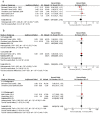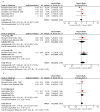Axillary radiotherapy: an alternative treatment option for adjuvant axillary management of breast cancer
- PMID: 27212421
- PMCID: PMC4876332
- DOI: 10.1038/srep26304
Axillary radiotherapy: an alternative treatment option for adjuvant axillary management of breast cancer
Abstract
Axillary lymph node dissection is standard management of axilla in invasive breast cancer. Radiotherapy also is important in local treatment. It is controversial as to whether axillary radiotherapy can displace axillary lymph node dissection. We performed a meta-analysis comparing axillary radiotherapy with axillary dissection. No significant difference was observed for disease free survival and overall survival between the radiation group and the dissection group. There was also no significant difference in either the axillary recurrence or the local recurrence between the two groups. But the axillary relapse rate in the radiation group was higher than in the surgery group at five-year follow-up while the local recurrence rate in the surgery group was higher than in the radiation group. A subgroup analysis showed that the difference in the axillary recurrence rate (RR = 0.20, P = 0.01) and local recurrence rate (RR = 4.7, P = 0.01) mainly appeared in the clinical node-positive subgroup. The edema rate in the surgery group was higher than in the radiation group (RR = 2.08, 95%: 1.71-2.54, P < 0.0001). We concluded that radiotherapy may be an alternative treatment option for adjuvant management of the axilla in selected sub-groups of patients.
Figures







References
-
- Fleissig A. et al.. Post-operative arm morbidity and quality of life. Results of the ALMANAC randomised trial comparing sentinel node biopsy with standard axillary treatment in the management of patients with early breast cancer. Breast Cancer Res Treat. 95, 279–293 (2006). - PubMed
-
- Deutsch M. et al.. The incidence of arm edema in women with breast cancer randomized on the National Surgical Adjuvant Breast and Bowel Project study B-04 to radical mastectomy versus total mastectomy and radiotherapy versus total mastectomy alone. Int J Radiat Oncol Biol Phys. 70, 1020–1024 (2008). - PubMed
Publication types
MeSH terms
LinkOut - more resources
Full Text Sources
Other Literature Sources
Medical

